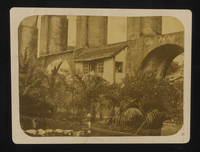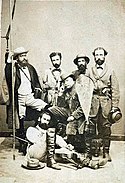Rafael Castro Ordóñez
| Rafael Castro Ordóñez | |
|---|---|
| Narození | 1830 Madrid |
| Úmrtí | 2. prosince 1865 (ve věku 34–35 let) |
| Alma mater | Královská akademie múzických umění San Fernando |
| Povolání | malíř a fotograf |
| Některá data mohou pocházet z datové položky. Chybí svobodný obrázek. | |

Rafael Castro Ordóñez (1830 nebo 1834 Madrid – 2. prosince 1865) byl španělský malíř, ilustrátor a fotograf, první španělský fotograf na vědecké expedici.[1] Narodil se v Madridu v roce 1834 nebo podle jiných autorů v roce 1830.[2][3] V letech 1848– 1850 studoval malbu a kresbu na Real Academia de Bellas Artes de San Fernando a před kariérou fotografa maloval jako ostatní malíři v té době;[4] z tohoto důvodu odcestoval do Paříže, aby se učil u malíře Léona Cognietiho, a když byl vybrán k výpravě do Tichého oceánu (La comisión científica del Pacífico), vyžádal si radu od Charlese Clifforda, který byl specialistou na cestovní fotografii, a který měl dokonce na starosti nákup potřebného materiálu v Londýně.
Pacifická vědecká komise (1862–1866)
Za vlády královny Isabely II. byla tato zámořská výprava uskutečněna za účelem propagace naturalistického a antropologického výzkumu a za podpory španělského koloniálního týmu pod velením generála Pinzóna. Jednotku tvořily fregaty Nuestra Señora del Triunfo a Resolución a škuner Covadonga. Lodě vypluly 10. srpna 1862 z přístavu v Cádizu do Střední Ameriky, Jižní Ameriky a Kalifornie.[5] Na druhou stranu se tato expedice pokoušela napodobit ostatní z různých zemí, zejména přírodovědce Alexandra von Humboldta z Německa.
Expediční tým se skládal ze tří zoologů, geologa, botanika, antropologa, taxidermisty a kreslíře – fotografa, což bylo místo, pro které byl vybrán Rafael Fernández de Moratín, ale který se nemohl ze zdravotních důvodů zúčastnit. Byl pověřen pracovat pro Rafaela Castra, ačkoli se účastnil jen v letech 1862–1864, protože opustil expedici v Guayaquil a fotografování měl na starost Marcos Jiménez de la Espada. Na nějaký čas se usadil ve Valparaíso a do Madridu se vrátil, když se vztahy s Chile zhoršily po obsazení ostrovů Chincha generálem Pinzónem.[2]
Jeho fotografická produkce zahrnovala od pohlednicových záběrů (města, krajiny, ruiny, památky) a lidských typů, až po studiové portréty. Fotografické vybavení, které používal, byly negativní skleněné desky a pozitivní kopie na albuminovém papíru.[6][7] Publikoval různé články a fotografie o cestě v ilustrovaném magazínu El Museo Universal v letech 1863–1864 (od čísla 7 z roku 1863 do čísla 46 z roku 1864).[1]
Přestože je Rafael Castro nejznámější svou fotografickou činností, před cestováním do Tichého oceánu se věnoval vizuálnímu umění a účastnil se několika národních výstav výtvarného umění v letech 1850 a 1858, jakož i v roce 1860, ve kterém získal čestné uznání za svou malbu s názvem Sancho García presentando a su madre la copa de vino emponzoñado que ésta le había preparado.
Rafael Castro Ordóñez 2. prosince 1865 spáchal z nejasných důvodů sebevraždu.[2]
Pro historii je považován za průkopníka cestovního zpravodajství. Zanechal důležitou sbírku obrazů, většina z nich se uchovala v archivech Národního muzea přírodních věd a Národního muzea antropologie v Madridu. Mezi výstavy jeho děl patří: Fuentes de la memoria I v roce 1989, Pacífico inédito v roce 1992 a Rafael Castro Ordóñez. Expedición del Pacífico v roce 1999.[1]
Galerie
Passeio Público de Salvador, 1862
Valparaíso, primer teatro de la Victoria (actual plaza Simón Bolivar), 1864
Valparaíso, quebrada San Francisco, 1863
Valparaíso, Teatro Barracas, (Actual av. Brasil), 1864
Valparaíso, Vista desde el Almendral desde el 1er teatro Victoria, 1863
Portrét, 1862
Portrét, 1862
Aqueduct of Saint Teresa - House Under the Arches, 1862
Odkazy
Reference
V tomto článku byl použit překlad textu z článku Rafael Castro Ordóñez na španělské Wikipedii.
- ↑ a b c ; Pérez Gallardo, H. [s.l.]: [s.n.] ISBN 84-376-2038-4. Sougez, M. L.; Pérez Gallardo, H. (2003). Diccionario de historia de la fotografía. Madrid: Ediciones Cátedra. str. 103. ISBN 84-376-2038-4. «Castro Ordóñez, Rafael (1830-1865)»..
- ↑ a b c Los expedicionarios / Rafael Castro y Ordóñez [online]. [cit. 2009-10-05]. Dostupné online. (anglicky)
- ↑ Miradas de otros tiempos. Rafael Castro Ordóñez [online]. [cit. 2008-10-08]. Dostupné online. (anglicky)
- ↑ [s.l.]: [s.n.] ISBN 8477826609. López Mondéjar, P. (1999). Historia de la fotografía en España (4ª edición). Barcelona: Lunwerg editores. str. 58. ISBN 8477826609..
- ↑ Almagro; Comisión Científica del Pacífico. [s.l.]: [s.n.] Dostupné online. Almagro, Manuel de; Comisión Científica del Pacífico (1866). Breve descripcion de los viajes hechos en América por la Comision científica. Madrid..
- ↑ Las Colecciones [online]. [cit. 2008-10-08]. Dostupné online. (anglicky)
- ↑ Tiempo de historia. La actualidad del pasado. Exposiciones. Muestra fotográfica sobre el viaje de la Comisión Científica española del Pacífico en 1862-1866 [online]. [cit. 2009-10-05]. Dostupné v archivu pořízeném dne 2009-12-13. ISSN 1885-6691. (anglicky)
Externí odkazy
 Obrázky, zvuky či videa k tématu Rafael Castro Ordóñez na Wikimedia Commons
Obrázky, zvuky či videa k tématu Rafael Castro Ordóñez na Wikimedia Commons - La comisión científica del Pacífico (1862–1866)
Média použitá na této stránce
Autor/Criador
Castro y Ordoñez, Rafael, 1834-1865
Título Passeio da Bahia [Iconográfico] Imprenta Salvador, BA : [s.n.], 1862.
Descrição original 1 foto : papel albuminado, p&b ; 19,9 x 26 cm.The Thereza Christina Maria collection is composed of 21,742 photos assembled by Emperor Pedro II (1825-91) throughout his life and donated by him to the National Library of Brazil. The collection covers a wide variety of subjects. It documents the achievements of Brazil and Brazilians in the 19th century and also includes many photographs of Europe, Africa, and North America. In 1862, the government of Spain under Queen Isabella II sent a team of naturalists to South America to collect objects for Spanish museums. The endeavor was known as the Scientific Commission of the Pacific. Rafael Castro y Ordonez, a draftsman on the commission, documented the trip in photographs, producing a pictorial record of the ethnic and cultural diversity of the Americas in the mid-19th century. This photograph was taken in the coastal state of Bahia. One of Brazil’s centers of sugar cultivation, it was also the home of most of the country’s slaves.
Memory of the World; Merchants; Peddlers; Portrait photographs; Portraits; Street vendors
Primer Teatro de la Victoria de Valparaíso foto de 1864.
Quebrada San Francisco de Valparaíso en 1863
Members of the Scientific Commission of the Pacific (1862-1865).
The Thereza Christina Maria collection is composed of 21,742 photos assembled by Emperor Pedro II (1825-91) throughout his life and donated by him to the National Library of Brazil. The collection covers a wide variety of subjects. It documents the achievements of Brazil and Brazilians in the 19th century and also includes many photographs of Europe, Africa, and North America. In 1862, the government of Spain under Queen Isabella II sent a team of naturalists to South America to collect objects for Spanish museums. The endeavor was known as the Scientific Commission of the Pacific. Rafael Castro y Ordonez, a draftsman on the commission, documented the trip in photographs, producing a pictorial record of the ethnic and cultural diversity of the Americas in the mid-19th century. This photograph was taken in the coastal state of Bahia. One of Brazil’s centers of sugar cultivation, it was also the home of most of the country’s slaves.
Memory of the World; Merchants; Peddlers; Portrait photographs; Portraits; Street vendors
Teatro Barracas en el borde costero de Valparaíso en 1863. Actualmente, sobre el mar que se ve en la foto, está la avenida Brasil
The Thereza Christina Maria collection is composed of 21,742 photos assembled by Emperor Pedro II (1825-91) throughout his life and donated by him to the National Library of Brazil. The collection covers a wide variety of subjects. It documents the achievements of Brazil and Brazilians in the 19th century and also includes many photographs of Europe, Africa, and North America. The Carioca Aqueduct, also called the Arcos da Lapa or simply, the Arches, was built in the early 18th century to carry fresh water from the Carioca River to the city of Rio de Janeiro. The aqueduct, which was inaugurated in 1750, runs 270 meters between the hills of Santa Thereza and São Anthony and consists of 42 arches in two levels. At the end of the 19th century, the aqueduct was adapted to provide a track for the Santa Tereza Historic Tramway, which runs from the center of Rio to the hilly neighborhood of Santa Tereza. It is the only tramway still operating in Rio today. The aqueduct was photographed by Rafael Castro y Ordonez as part of the Scientific Commission of the Pacific.
Aqueducts; Buildings; Memory of the World; The Arches (Rio de Janeiro)
Valparaíso, Vista desde el Almendral desde el 1er teatro Victoria
















